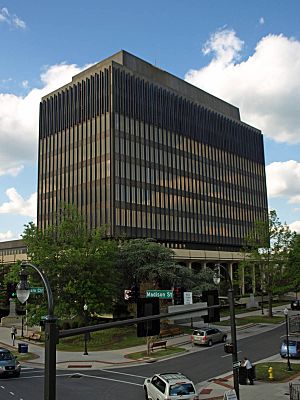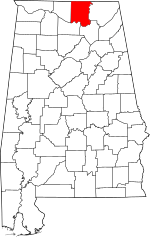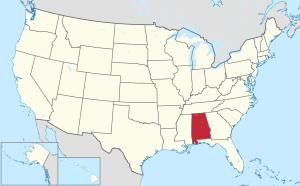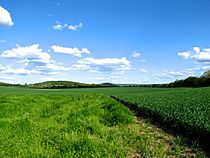Madison County, Alabama facts for kids
Quick facts for kids
Madison County
|
||
|---|---|---|

Madison County Courthouse in Huntsville
|
||
|
||

Location within the U.S. state of Alabama
|
||
 Alabama's location within the U.S. |
||
| Country | ||
| State | ||
| Founded | December 13, 1808 | |
| Named for | James Madison | |
| Seat | Huntsville | |
| Largest city | Huntsville | |
| Area | ||
| • Total | 813 sq mi (2,110 km2) | |
| • Land | 802 sq mi (2,080 km2) | |
| • Water | 11 sq mi (30 km2) 1.4% | |
| Population
(2020)
|
||
| • Total | 388,153 | |
| • Estimate
(2023)
|
412,600 |
|
| • Density | 477.43/sq mi (184.34/km2) | |
| Time zone | UTC−6 (Central) | |
| • Summer (DST) | UTC−5 (CDT) | |
| Congressional district | 5th | |
|
||
Madison County is a county located in the north central portion of the U.S. state of Alabama. As of the 2020 Census, the population was 388,153, and according to a 2023 population estimate the county has become the second-most populous county in Alabama. Its county seat is Huntsville. Since the mid-20th century it has become an area of defense and space research and industry. The county is named in honor of James Madison, fourth President of the United States and the first President to visit the state of Alabama. Madison County covers parts of the former Decatur County. Madison County is included in the Huntsville, Alabama Metropolitan Statistical Area.
Contents
History
Madison County was established on December 13, 1808, by the governor of the Mississippi Territory. It is recognized as the "birthplace" of the state of Alabama, which was admitted to the Union on December 14, 1819. Huntsville was designated as the first capital of the new state.
For much of the county's history, its economy was based on agriculture, particularly cotton plantations, which were established across the uplands. These plantations and their owners' profits were dependent on the labor of enslaved African Americans before the Civil War. Madison County was one of the largest cotton-producing counties in the state.
Madison County was the largest county in Alabama in population from 1810 to 1840. In the 1810 census alone, Madison County made up nearly half of the population in what would become Alabama, though this did not include Native American tribes and their people. By 1850 however it would lose the title and be the 7th due to its population growth having slowed down. The likely reason was due to Madison County having mainly relied on cotton with little to no other industries.
Cotton remained important after the war. Most labor for cultivation was still provided by African Americans, but they worked as sharecroppers and tenant farmers. By the late 19th century, textile mills had been established around the county; they were restricted to white workers by the Jim Crow practices of racial segregation. During the early 20th century, the economy continued to be largely agricultural, although textile mills expanded their production.
During World War II, the Army established Redstone Arsenal here as a chemical weapon manufacturing site, and the county attracted related industries. After the war, it became a center of new weapon and rocket development. In 1950, a group of exiled German rocket scientists, led by Wernher von Braun, came to Redstone Arsenal from Fort Bliss, Texas in order to conduct research and development of new types of rockets.
By the 1960s, research expanded to rockets for space exploration. The Redstone rocket was modified to launch the first two Americans into space. The US began to emphasize investment in the Space Race, in order to compete with the Soviet Union during the Cold War years and to increase scientific gains. This work in the defense and space industries has generated tens of thousands of jobs in the area, most of them private contractors working in these fields. The population of Madison County has risen from 72,903 in 1950 to an estimated 403,565 in 2022.
Geography
According to the United States Census Bureau, the county has a total area of 813 square miles (2,110 km2), of which 802 square miles (2,080 km2) is land and 11 square miles (28 km2) (1.4%) is water.
The topography in the southern and eastern portions of the county is dominated by the dissected remnants of the Cumberland Plateau, such as Keel Mountain, Monte Sano Mountain and Green Mountain. The northern and western portions of the county are flatter.
Rivers
Adjacent counties

- Lincoln County, Tennessee (north)
- Franklin County, Tennessee (northeast)
- Jackson County (east)
- Marshall County (southeast)
- Morgan County (southwest)
- Limestone County (west)
National protected area
Demographics
| Historical population | |||
|---|---|---|---|
| Census | Pop. | %± | |
| 1810 | 4,699 | — | |
| 1820 | 17,481 | 272.0% | |
| 1830 | 27,990 | 60.1% | |
| 1840 | 25,706 | −8.2% | |
| 1850 | 26,427 | 2.8% | |
| 1860 | 26,451 | 0.1% | |
| 1870 | 31,267 | 18.2% | |
| 1880 | 37,625 | 20.3% | |
| 1890 | 38,119 | 1.3% | |
| 1900 | 43,702 | 14.6% | |
| 1910 | 47,041 | 7.6% | |
| 1920 | 51,268 | 9.0% | |
| 1930 | 64,623 | 26.0% | |
| 1940 | 66,317 | 2.6% | |
| 1950 | 72,903 | 9.9% | |
| 1960 | 117,348 | 61.0% | |
| 1970 | 186,540 | 59.0% | |
| 1980 | 196,966 | 5.6% | |
| 1990 | 238,912 | 21.3% | |
| 2000 | 276,700 | 15.8% | |
| 2010 | 334,811 | 21.0% | |
| 2020 | 388,153 | 15.9% | |
| 2023 (est.) | 412,600 | 23.2% | |
| U.S. Decennial Census 1790–1960 1900–1990 1990–2000 2010–2020 |
|||
2020 census
| Race / Ethnicity | Pop 2000 | Pop 2010 | Pop 2020 | % 2000 | % 2010 | % 2020 |
|---|---|---|---|---|---|---|
| White alone (NH) | 196,496 | 221,445 | 237,497 | 71.01% | 66.14% | 61.19% |
| Black or African American alone (NH) | 62,602 | 79,517 | 91,079 | 22.62% | 23.75% | 23.46% |
| Native American or Alaska Native alone (NH) | 2,067 | 2,335 | 2,132 | 0.75% | 0.70% | 0.55% |
| Asian alone (NH) | 5,107 | 8,167 | 10,179 | 1.85% | 2.44% | 2.62% |
| Pacific Islander alone (NH) | 140 | 321 | 450 | 0.05% | 0.10% | 0.12% |
| Other race alone (NH) | 300 | 471 | 1,702 | 0.11% | 0.14% | 0.44% |
| Mixed race or Multiracial (NH) | 4,762 | 7,151 | 20,178 | 1.72% | 2.14% | 5.20% |
| Hispanic or Latino (any race) | 5,226 | 15,404 | 24,936 | 1.89% | 4.60% | 6.42% |
| Total | 276,700 | 334,811 | 388,153 | 100.00% | 100.00% | 100.00% |
As of the 2020 census, there were 388,153 people, 157,770 households, and 101,684 families residing in the county. The population density was 484.2 inhabitants per square mile (187.0/km2) There were 169,820 housing units.
2010
As of the 2010 census, there were 334,811 people, 109,955 households, out of which 33.00% had children under the age of 18 living with them; 53.40% were married couples living together, 11.80% had a female householder with no husband present, and 31.50% were non-families. Nearly 27.20% of all households were made up of individuals, and 7.40% had someone living alone who was 65 years of age or older. The average household size was 2.45, and the average family size was 3.00.
In the county, the population was spread out, with 25.60% under the age of 18, 9.40% from 18 to 24, 31.50% from 25 to 44, 22.70% from 45 to 64, and 10.80% who were 65 years of age or older. The median age was 36 years. For every 100 females, there were 95.30 males. For every 100 females age 18 and over, there were 92.10 males.
The median income for a household in the county was $44,704, and the median income for a family was $54,360. Males had a median income of $40,779 versus $26,534 for females. The per capita income for the county was $23,091. About 8.10% of families and 10.50% of the population were below the poverty line, including 14.10% of those under age 18 and 9.60% of those age 65 or over.
2000
As of the 2000 census, there were 276,700 people, 109,955 households, and 75,319 families residing in the county. The population density was 344 people per square mile (133 people/km2). There were 120,288 housing units at an average density of 149 units per square mile (58 units/km2). The racial makeup of the county was 72.06% White, 22.78% Black or African American, 0.77% Native American, 1.86% Asian, 0.06% Pacific Islander, 0.59% from other races, and 1.89% from two or more races. Nearly 1.91% of the population were Hispanic or Latino of any race.
According to the 2000 census, the largest ancestry groups in Madison County were English 50.2%, African 22.78%, Scots-Irish 8.71%, Irish 4.3%, Scottish 4.12%, and Welsh 2.9%.
Communities
Cities
- Huntsville (county seat; partly in Limestone County and partly in Morgan County)
- Madison (partly in Limestone County)
- New Hope
- Owens Cross Roads
Towns
Census-designated places
- Harvest
- Hazel Green
- Meridianville
- Moores Mill
- New Market
- Redstone Arsenal
Unincorporated communities
Education
The Madison County School System runs public schools throughout the unincorporated areas of the county and the incorporated and unincorporated communities of: Gurley, Harvest, Hazel Green, Meridianville, Moores Mill, New Hope, Owens Cross Roads, New Market, Redstone Arsenal. It also includes a few parcels of Huntsville. The system also includes Toney and Monrovia. The system runs 14 elementary schools, 4 middle schools, 5 high schools and a ninth grade school, and a career/technical center.
High schools in the Madison County School System are:
- Buckhorn High School (New Market)
- Hazel Green High School
- Madison County High School (Gurley)
- New Hope High School
- Sparkman High School (Harvest)
There are a number of private schools serving Madison County. These include Randolph School, Madison Academy, Westminster Christian Academy, Faith Christian Academy, and several others.
Madison City and the vast majority of Huntsville both have their own separate school systems (Madison City School District and Huntsville City School District). The Madison City School District also includes the town of Triana.
Transportation
Major highways
 Interstate 565
Interstate 565 U.S. Highway 72 (University Drive in Huntsville city limits)
U.S. Highway 72 (University Drive in Huntsville city limits) U.S. Highway 231 (Memorial Parkway in Huntsville city limits)
U.S. Highway 231 (Memorial Parkway in Huntsville city limits) U.S. Highway 431 (Governors Drive in Medical District of Huntsville; Memorial Parkway for rest of length in Huntsville City Limits)
U.S. Highway 431 (Governors Drive in Medical District of Huntsville; Memorial Parkway for rest of length in Huntsville City Limits) State Route 53 (Jordan Lane in much of Huntsville city limits)
State Route 53 (Jordan Lane in much of Huntsville city limits) State Route 255 (Research Park Boulevard)
State Route 255 (Research Park Boulevard)
Transit
- Orbit
Rail
- Norfolk Southern Railway
- Huntsville and Madison County Railroad Authority
Air travel
The Port of Huntsville provides both passenger air service, via Huntsville International Airport which allows access to most of the rest of the United States, and shipping air service, via the International Intermodal Center. There are also three smaller public airports in the county: Hazel Green Airport, Madison County Executive Airport, and Moontown Airport.
Bicycle routes
There are several bicycle routes in the city of Huntsville. Madison County has a master plan to develop a 70-mile bicycle and walking trail.
Places of interest
Madison County is home to Monte Sano State Park, the U.S. Space & Rocket Center, and part of the Flint River. It also contains Hampton Cove Golf Course, part of the Robert Trent Jones Golf Trail. There is a historical marker for Lincoln School and Village which were incorporated into Huntsville in 1956.
See also
 In Spanish: Condado de Madison (Alabama) para niños
In Spanish: Condado de Madison (Alabama) para niños


